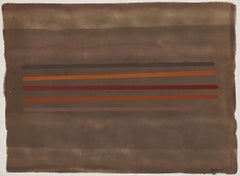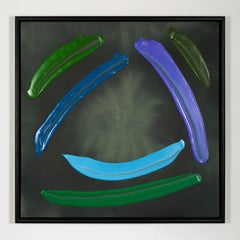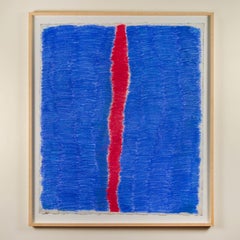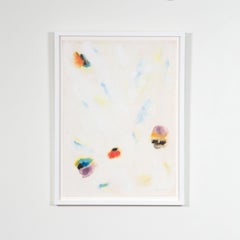Want more images or videos?
Request additional images or videos from the seller
1 of 14
Rita LetendreBrahms and the Twilight1982
1982
$14,500List Price
About the Item
- Creator:Rita Letendre (1929-, Canadian)
- Creation Year:1982
- Dimensions:Height: 25.25 in (64.14 cm)Width: 39.75 in (100.97 cm)
- Medium:
- Movement & Style:
- Period:
- Condition:Very good condition.
- Gallery Location:Toronto, CA
- Reference Number:Seller: 12-241stDibs: LU215215508342
About the Seller
4.8
Vetted Professional Seller
Every seller passes strict standards for authenticity and reliability
Established in 2009
1stDibs seller since 2015
197 sales on 1stDibs
Typical response time: 13 hours
Authenticity Guarantee
In the unlikely event there’s an issue with an item’s authenticity, contact us within 1 year for a full refund. DetailsMoney-Back Guarantee
If your item is not as described, is damaged in transit, or does not arrive, contact us within 7 days for a full refund. Details24-Hour Cancellation
You have a 24-hour grace period in which to reconsider your purchase, with no questions asked.Vetted Professional Sellers
Our world-class sellers must adhere to strict standards for service and quality, maintaining the integrity of our listings.Price-Match Guarantee
If you find that a seller listed the same item for a lower price elsewhere, we’ll match it.Trusted Global Delivery
Our best-in-class carrier network provides specialized shipping options worldwide, including custom delivery.You May Also Like
"Color Field (Chalk on Wet Paper)" original pastel by Sylvia Spicuzza
By Sylvia Spicuzza
Located in Milwaukee, WI
In this composition, Sylvia Spiczza works in the manner of color field artists like Mark Rothko and Helen Frankenthaler, presenting a gradation of colors shifting from yellow to red ...
Category
1960s Color-Field Abstract Drawings and Watercolors
Materials
Pastel
$2,430
H 25.75 in W 19.75 in
Abstract Painting of Vivid Colors Painting of Layered Curvilinear Forms, Paper
By Natalia Roman
Located in Barcelona, ES
"Layered Curvilinear Forms" is an abstract painting diptych by Spanish artist Natalia Roman. It is a beautiful series of rhythmic brushstrokes and shapes combined with subtle tones a...
Category
2010s Color-Field Abstract Paintings
Materials
Acrylic, Oil Crayon, Handmade Paper
Summer solstice moon - Abstract color field stain painting
Located in Philadelphia, PA
'summer solstice moon' 26"x24" acrylic and oil pigment stick on raw cotton canvas by Abstract painter Elisa Niva.
This earthy and soft painting uses the soak- method created by He...
Category
2010s Color-Field Abstract Paintings
Materials
Oil Crayon, Cotton Canvas, Acrylic
$504 Sale Price
27% Off
H 26 in W 24 in D 1 in
Earthen Tantra painting #3 - Abstract tantric stain painting
Located in Philadelphia, PA
Earthen Tantra painting #3 - Abstract tantric stain painting 28" x30" Acrylic and oil pigment stick on raw cotton canvas by abstract artist Elisa Niva....
Category
2010s Color-Field Abstract Paintings
Materials
Oil Crayon, Cotton Canvas, Acrylic
$504 Sale Price
27% Off
H 30 in W 28 in D 1 in
Old School Board Original Painting Science Art Series
Located in Zofingen, AG
“Old School Board”
Original Painting Science Art Series
Size: 50 x 60 cm
Medium: Acrylic on canvas
Artist Certificate included
A part of the Science Art series by international art...
Category
21st Century and Contemporary Color-Field Abstract Paintings
Materials
Oil Pastel, Acrylic
$610
H 19.69 in W 23.63 in D 0.71 in
Battle of the Sexes, Mathematical Conceptual Abstraction, Science Art Collection
By Anastasia Vasilyeva
Located in Zofingen, AG
This artwork was made in the Colorfield concept with the character elements - the formulas on the painting are from mathematical game theory.
In game theory, the battle of the sexes...
Category
2010s Color-Field Abstract Paintings
Materials
Canvas, Oil Pastel, Acrylic
$1,762
H 47.25 in W 31.5 in D 0.71 in
Pop Rocks, Colorful Stone Stack Pile, Red, Pink, Green, 3D Render Shapes, Paper
By Ryan Rivadeneyra
Located in Barcelona, ES
"Pop Rocks" is an acrylic painting from Ryan Rivadeneyra's series of imagined modernist sculptures. In this series, Rivadeneyra explores the possibilities of...
Category
2010s Color-Field Interior Paintings
Materials
Watercolor, Handmade Paper, Oil Pastel
$656 Sale Price
20% Off
H 40 in W 28 in
Dexter's Choice State II, signed mixed media watercolor (unique variant), Framed
By Larry Zox
Located in New York, NY
Larry Zox
Dexter's Choice, State II, ca. 1990
Mixed media, Watercolor pochoir, and Oil stick Wax, Water-Based Crayons, on heavy Arches museum watercolor rag paper with deckled edges
...
Category
1990s Color-Field Abstract Drawings and Watercolors
Materials
Crayon, Mixed Media, Oil, Watercolor, Graphite, Monoprint
$6,000 Sale Price
40% Off
H 42 in W 62 in D 1.5 in
Larry Zox, original Red, White and Blue acrylic painting, signed, dated, framed
By Larry Zox
Located in New York, NY
Larry Zox
Red, White and Blue painting, 1963
Original acrylic painting on board
Signed and dated upper right front; Signed, titled and dated on the back as well
Unique
This work was originally sold by Jill Kornblee of the legendary Kornblee Gallery, with the back of the panel bearing Kornblee's original Upper East Side address before the gallery moved to West 57th Street
Frame included:
Elegantly double framed.
Measurements:
Outer Frame
13.5 inches vertical by 13.5 horizontal by 2.5 inches
Original Frame:
10 inches vertical by 9.75 inches horizontal
Painting
9.25 inches vertical x 9 inches horizontal
Larry Zox Biography:
A PAINTER who played an essential role in the Color Field discourse of the 1960s and 1970s, Larry Zox is best known for his intensely and brilliantly colored geometric abstractions that question and violate symmetry.1 Zox stated in 1965: “Being contrary is the only way I can get at anything.” To Zox, this position was not necessarily arbitrary, but instead meant “responding to something in an examination of it [such as] using
a mechanical format with X number of possibilities.”2 What he sought was to “get at the specific character and quality of each painting in and for itself,” as James Monte stated in his introductory essay in the catalogue for Zox’s 1973–1974 solo exhibition at the Whitney Museum of American Art.3 Zox’s robust paintings reveal
a celebrated artist and master of composition who is explored and challenged the possibilities of Post-Painterly Abstraction and Minimalist pictorial conventions.
Zox began to receive attention in the 1960s when he was included in several groundbreaking exhibitions of Color Field and Minimalist art, including Shape and Structure (1965), organized by Henry Geldzahler and Frank Stella for Tibor de Nagy, New York, and Systemic Painting (1966), organized by Lawrence Alloway for the Solomon R. Guggenheim Museum, New York. In 1973–1974, the Whitney’s solo exhibition of Zox’s work gave recognition to his significance in the art scene of the preceding decade. In the following year, he was represented in the inaugural exhibition of the Hirshhorn Museum and Sculpture Garden, Wahsington, DC, which acquired fourteen of his works.
Zox was born in Des Moines, Iowa in 1937. He attended the University of Oklahoma and Drake University, Des Moines, Iowa, and then studied under George Grosz at the Des Moines Art Center. In 1958, Zox moved to New York, joining the downtown art scene. His studio on 20th Street became a gathering place for artists, jazz musicians, bikers, and boxers, and he occasionally sparred with visiting fighters. He later established a studio in East Hampton, a former black smithy used previously by Jackson Pollock.
In his earliest works, such as Banner (1962) Zox created
collages consisting of pieces of painted paper stapled onto sheets of plywood. He then produced paintings that were illusions of collages, including both torn- and trued-edged forms, to which he added a wide range of strong hues that created ambiguous surfaces. In paintings such as For Jean (1963), he omitted the collage aspect of his work and applied flat color areas to create more complete statements of pure color and shape. He then replaced these torn and expressive edges with clean and impersonal lines that would define his work for the next decade.
From 1962 to 1965, he produced his Rotation series, at first creating plywood and Plexiglas reliefs, which turned squares into dynamic polygons. He used these shapes in his paintings as well, employing white as a foil between colors to produce negative spaces that suggest that the colored shapes had only been cut out and laid down instead of painted. The New York Times in 1964 wrote of the works in show such as Rotation B (1964) and of the artist: “The artist is hip, cool, adventurous, not content to stay with the mere exercise of sensibility that one sees in smaller works.”4
In 1965, he began the Scissor Jack series, in which he arranged opposing triangular shapes with inverted Vs of bare canvas at their centers that threaten to split their compositions apart. In several works from this series, Zox was inspired by ancient Chinese water vessels. With a mathematical precision and a poetic license, Zox flattened the three dimensional object onto graph paper, and later translated his interpretation of the vessel’s lines onto canvas with masking tape, forming the structure of the painting.
The Diamond Cut and Diamond Drill paintings...
Category
1960s Color-Field Abstract Paintings
Materials
Acrylic
$15,000
H 13.5 in W 13.5 in D 2.5 in
1960s Paul Feeley School Color Field Painting
Located in New York, NY
School of Paul Feeley
Untitled, c. 1960s
Oil on canvas
20 x 59 5/8 in.
Signed lower right
Primarily a painter, Paul Feeley (American, 1910 - 1966) favored canvases with simple geome...
Category
1970s Color-Field Abstract Paintings
Materials
Canvas, Oil
More From This Seller
View AllLa Plonge #23
By William Perehudoff
Located in Toronto, Ontario
William Perehudoff (1918-2013) is one of the most cherished and collected Canadian abstract painters. His work exemplifies how color field painting was expressed in Canada.
Like some of his contemporaries, he was encouraged and guided by legendary New York critic Clement Greenberg. Perehudoff spent several summers at the University of Saskatchewan's legendary Emma Lake Artist's Workshop where he worked and studied with Jules Olitski and Kenneth Noland during the 1960s.
Perehudoff is known for his simple and exuberant compositions that juxtapose and celebrate color. His series "La Plonge...
Category
1980s Color-Field Abstract Paintings
Materials
Gouache
Gentleman's Choice
By William Perehudoff
Located in Toronto, Ontario
William Perehudoff (1918-2013) is one of the most cherished and collected Canadian abstract painters. His work is a prime example of how color field painting was expressed in Canada....
Category
1980s Color-Field Abstract Paintings
Materials
Canvas, Acrylic
Untitled
Located in Toronto, Ontario
Françoise Sullivan (b. 1923) is a trailblazing force in Canadian art, recognized not only for her groundbreaking work in modern dance but also for her prolific and versatile contribu...
Category
Early 2000s Abstract Expressionist Abstract Paintings
Materials
Pastel
Untitled
By Gershon Iskowitz
Located in Toronto, Ontario
It is somewhat hard to reconcile Gershon Iskowitz's (1921-1988) aesthetic with his personal history.
Born to a religious family in Poland, Iskowitz was allowed to leave Yeshiva (Jew...
Category
1960s Abstract Abstract Paintings
Materials
Watercolor
Charles Pachter "Oro Barns"
By Charles Pachter
Located in Toronto, Ontario
Charles Pachter (b. 1942) is one of the most collected and cherished Canadian artists.
His iconic, uplifting and patriotic images have independently earned their place in the natio...
Category
1980s Contemporary Abstract Paintings
Materials
Acrylic
Silent Light
By Harold Town
Located in Toronto, Ontario
Harold Town (1924-1990) is renowned across Canada and beyond for his eclectic and dynamic body of work.
In the 1950s, Town established his reputation with a series of abstract mono...
Category
1960s Abstract Geometric Abstract Paintings
Materials
Canvas, Lucite, Oil
Recently Viewed
View AllMore Ways To Browse
1930s Abstract Oil Paintings
9th Street Art
A David Crown
A Raymond Katz
Abstract Burnt Orange Art
Alfred King
Anderson Abstract Painting 1960
Angel Ricardo Rios
Bai Ming On Sale
Berk Artist
Beth Barry
Betsy Brown Paintings
Black Gradient Painting
Broken Glass Art
Budd Hopkins
Christian Religious Art
Cubist Painting 1980s
David Hirst



